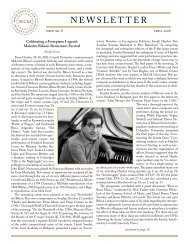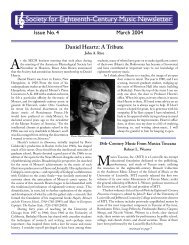NEWSLETTER - Society for 18th-Century Music
NEWSLETTER - Society for 18th-Century Music
NEWSLETTER - Society for 18th-Century Music
You also want an ePaper? Increase the reach of your titles
YUMPU automatically turns print PDFs into web optimized ePapers that Google loves.
Haydn Quartet Cycle<br />
The New Esterházy Quartet (Kati Kyme, Lisa Weiss, Anthony<br />
Martin, William Skeen) continues its Haydn Cycle, the first ever in<br />
America on period instruments, with concerts in San Francisco’s<br />
St. Mark’s Lutheran Church. In the past two seasons the ensemble<br />
has appeared in 16 of 18 scheduled concerts. With these per<strong>for</strong>mances,<br />
the Quartet has presented 52 of Haydn’s 68 quartets! Two<br />
concluding concerts will take place this coming fall. In the spring<br />
of 2010, the Quartet will present Haydn Extras and Encores, a concert<br />
featuring selections from the Seven Words, an arrangement<br />
of “The Seasons” by Sigismund Neukomm, Roman Hofstetter’s<br />
celebrated Serenade, a Suite of Minuets from quartets by students<br />
of Haydn, an Adagio & Fugue by Georg Werner (Haydn’s predecessor<br />
at Esterházy), and an American premier of Maximilian<br />
Stadler’s Andante on a theme from Der Greise, a work written <strong>for</strong><br />
Haydn and per<strong>for</strong>med with permission from the Hungarian National<br />
Széchényi Library, Esterházy Collection. The Quartet will<br />
begin a new series called Dedicated to Haydn, featuring quartets<br />
from the numerous sets dedicated to Haydn, including those by<br />
Mozart, Pleyel, Wikmanson, Gyrowetz, and others. The New Esterházy<br />
Quartet recently released its second live-per<strong>for</strong>mance CD<br />
entitled Big Hits from the 50’s featuring three quartets from Opp.<br />
50, 54, and 55. The New Esterházy Quartet also recently per<strong>for</strong>med<br />
in New York at Christ and St. Stephen’s Church in Manhattan. To<br />
learn more about the New Esterházy Quartet, their Haydn Cycle,<br />
concerts, and recordings, please consult www.newesterhazy.org.<br />
The New Esterházy Quartet<br />
Conference Report<br />
Bianca de Mario<br />
Antonio Brioschi e il nuovo stile musicale del Settecento lombardo:<br />
ricerca storico-critica, prassi esecutiva, aspetti produttivi.<br />
Last September the Antonio Brioschi International Conference<br />
in Alessandria (Piedmont) concluded with two concerts with<br />
Vanni Moretto as conductor. The well-known Atalanta Fugiens Orchestra<br />
per<strong>for</strong>med the first concert in Saint Peter’s Cathedral; the<br />
second being per<strong>for</strong>med by the new Antonio Brioschi Orchestra,<br />
an ensemble of students who participated in the workshop entitled<br />
New Eighteenth-<strong>Century</strong> <strong>Music</strong>al Style of Lombardy and Piedmont.<br />
These young musicians per<strong>for</strong>med the Jewish cantata Dio, Clemenza<br />
e Rigore, marking the only per<strong>for</strong>mance since the work premiered<br />
in 1733.<br />
Antonio Brioschi (fl.1725–1750) was a prolific Milanese composer<br />
who experimented with new <strong>for</strong>ms and styles that <strong>for</strong>eshadowed<br />
what various European courts would later adopt, the socalled<br />
classical symphonic style. Brioschi served not only as the<br />
main topic of the conference but also as a starting point of broader<br />
project, the Archivio della Sinfonia Milanese, whose objectives are<br />
the creation of a centre devoted to the acquisition of compositions<br />
by Lombard composers, the publication of new critical editions,<br />
and the recording and per<strong>for</strong>mance of instrumental music in the<br />
eighteenth century.<br />
Participants in the conference included Cristiano Ostinelli (Casa<br />
Ricordi’s General Manager), Luciano Rebeggiani (Sony <strong>Music</strong><br />
Entertainment’s Director <strong>for</strong> Classics and Jazz), and a number of<br />
musicologists. Cesare Fertonani (Univesità degli Studi di Milano)<br />
defined ‘Milanese Symphony and Milanese Style’; Luca Aversano<br />
(Università degli Studi Roma Tre) explained how the term ‘Classicism’<br />
could be applied to the new instrumental practices in Lombardy<br />
and Piedmont; Matteo Giuggioli (Università degli Studi di<br />
Pavia) introduced Hepokowski and Darcy’s Elements of Sonata<br />
Theory and its application in the symphonies of Milanese composers;<br />
Sarah Mandel-Yehuda (Bar-Ilan University of Ramat Gan, Israel),<br />
editor of a recent Ricordi publication of Brioschi’s twelve<br />
symphonies, addressed the authorship, origins, and chronology of<br />
the composer’s manuscripts; Brioschi’s influence on the development<br />
of the Swedish symphonies of Johan Helmich Roman was<br />
examined by Bertil Van Boer (Western Washington University);<br />
Rudolf Rasch (Utrecht University) discussed <strong>for</strong>mal variations in<br />
the symphonic repertoire of the Amsterdam Theatre between the<br />
late Baroque and early Classic periods. Francesco Spagnolo (Judah<br />
L. Magnes Museum - Berkeley) and Renato Meucci (Cantelli<br />
Conservatory of Novara) examined the cultural and musical environment<br />
surrounding Brioschi, including the musical interaction<br />
between Jewish and Christians in Casale Monferrato and instruments<br />
and their makers. Vanni Moretto, session chair and orchestra<br />
conductor, discussed per<strong>for</strong>mance practice issues relating to<br />
Brioschi as well as <strong>for</strong>mal aspects in the composer’s works that<br />
help define a Milanese style.<br />
Students from the University of Milan Department of <strong>Music</strong><br />
concluded the Sunday morning session with a discussion of some<br />
recently discovered composers, such as Gaetano Piazza, Carlo<br />
Monza, Ferdinando Galimberti, Giuseppe Paladino, Andrea Zani,<br />
Ferdinando Brivio, and Francesco Zappa. Cataloguing problems<br />
were also addressed.<br />
8





